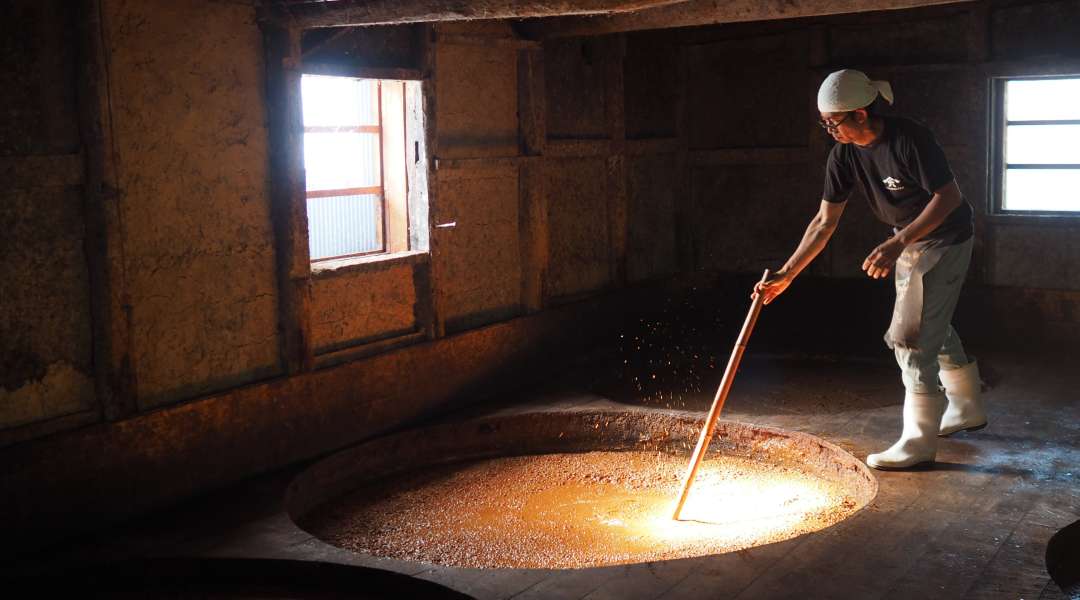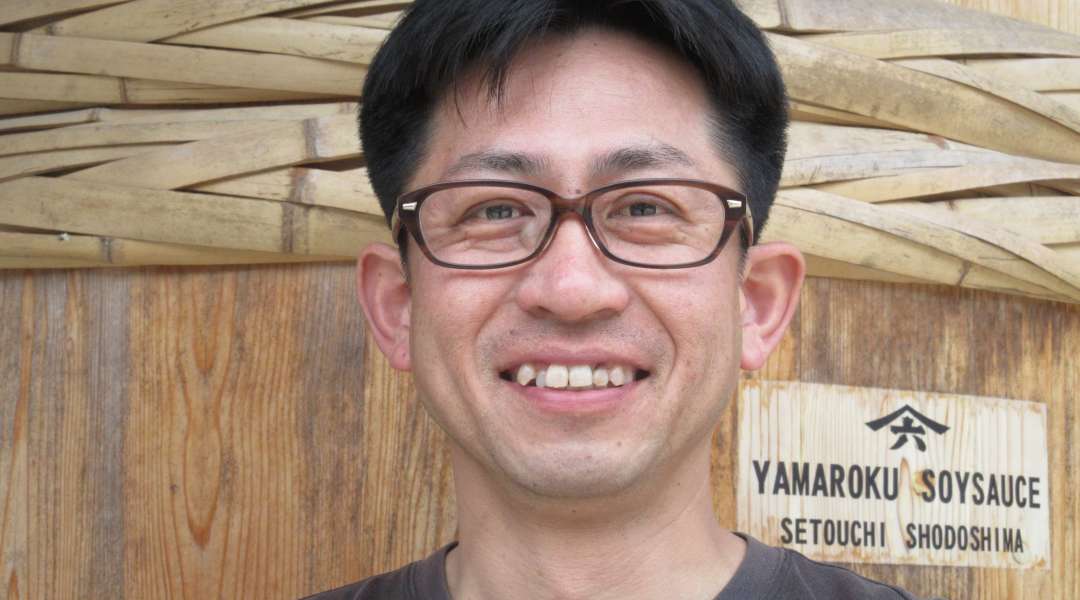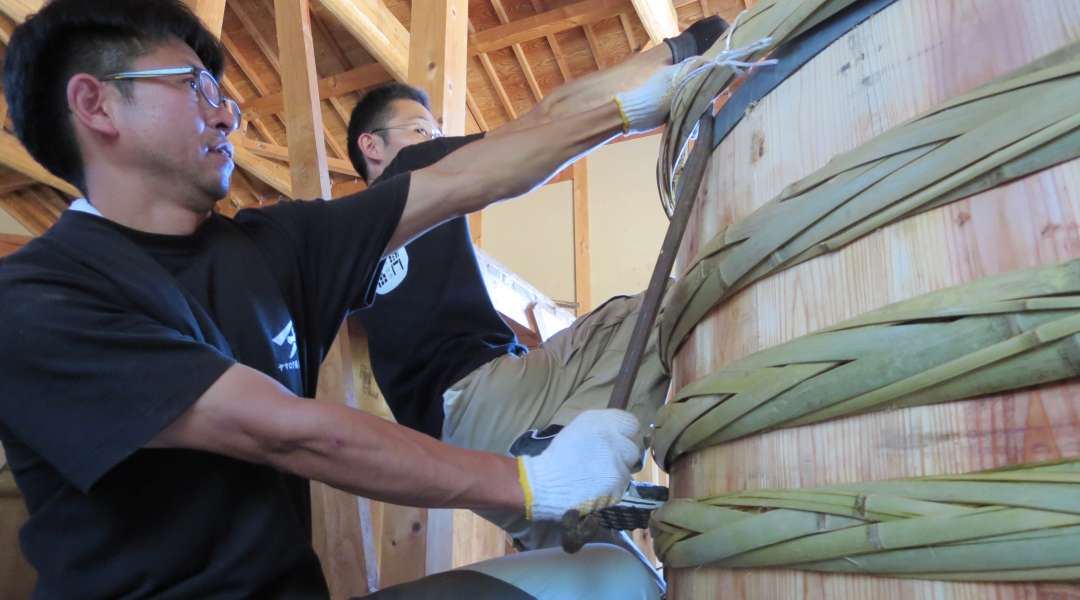
It's been 7 years since UNESCO added “Washoku”, (和食, Japanese cuisine) to the Intagible Cultural Heritage list back in 2013. Today, a number of Japanese chain restaurants such as YO! Sushi and Shoryu are available in the UK and the report by CGA and AlixPartners revealed that there has been 44% increase on Japanese sites from 2013 to 2018.
When cooking Japanese food, Soy Sauce (醬油, "Shoyu") is an absolute MUST ingredient and as you'll disover, is closely attached to Japanese daily life.

Q: Hi Yamamoto-san! Tell us a little bit about yourself and your company.
A: My name is Yasuo Yamamoto and I’m a fifth generation soy sauce producer, operating a roughly 150 year old soy sauce brewery business, Yamaroku Shoyu, located on the island of Shodoshima, in the beautiful Seto Inland Sea. We specialise in and produce all of our soy sauce using a traditional brewing method called Tennen Jouzou Kioke Shikumi (天然醸造木桶仕組み, ‘natural brewing wooden barrel method’), which currently accounts for just about 1% of all soy sauce production.
Q: We read that you weren’t always planning on going down the soy sauce production road, but what made you decide to continue the family business in the end?
A: My father told me not to inherit the family business as it is hard to make profit producing soy sauce with this traditional method. So I got a job as a sales rep at local food company. There, I experienced first hand the situation regarding food and the big emphasis that is placed on pricing. Even with additive-free high quality goods, buyers would always try to beat down prices as much as possible to the point where, if you weren’t selling artificially produced products at a low price, you wouldn’t sell anything at all. With authentically produced food gradually disappearing, I kind of felt like I didn’t want to have to go and try to sell to those aggressive buyers. I wanted to make those buyers come to me, asking for me to sell to them. I thought it just might be possible if it was soy sauce brewed in the traditional wooden barrels we had at home, and so decided to take up the family business, after all.
Q:What’s a day in the life of a soy sauce brewer like?
A: I work from roughly 6:00 in the morning to 19:00 or 20:00 in the evening. That doesn’t necessarily mean I’m busy brewing every day, though, as it takes a number of years to complete just one cycle in soy sauce brewing terms. Because we’re a small business, a lot of the time I’m looking after all the parts a CEO would usually look after, like paperwork, shipping logistics and preparation etc on top of the brewing itself.
Q: You mentioned that, in Japan, just under 1% of all soy sauce production comes from the traditional wooden barrel method. What were the reasons you decided to focus solely on the ‘kioke’ wooden barrel?
A: Simply put, “it’s tasty!”. The reason why the barrel method makes it tastier has not been proven in science. However, the same applies as with wine, whiskey and bourbon etc - the soy sauce becomes delicious when it’s aged in a wooden barrel over a long period of time.
Q: We’ve heard that you actually make the barrels yourself, too, but how long does it take to complete one barrel and what sort of man-power is required? Are they able to be used for a long time once complete?
A: Making ‘kioke’ wooden barrels takes a surprising amount of time. After preparing the materials, like the local bamboo and cedar planks, it takes roughly 10 days and 5 people to build. The braided bamboo hoop that goes around the barrel, called ‘Taga’, I actually make myself but in order to harvest the bamboo from the grove, cut it down to size, bring it home and make sure the taga hoop fits, it takes a lot more time and definitely more than just one person. As for the finished product, the salt involved in the brewery process means the wood doesn’t really rot, so they can last over a 100 years if used properly and carefully.

Q: What about your fellow employees? What kind of a team does it take to make the soy sauce?
A: At the moment, it’s officially just me and one other person, with about 7 other people who help out on a part time basis. The actual brewing I tend to take of myself but I have been getting help from the part timers every now and then lately.
Q: When it comes to making soy sauce, is there one thing you personally will not compromise on?
A: Of course! The ‘kioke’ barrels! The soy sauce they produce is just so delicious.
Q: Have there been any particular highlights or lowlights in the years since you took over the business?
A: I’d have to say the hardest thing was when my father sadly suddenly passed away and I was left to continue the business alone. It only happened about 2 years after I came back to the business so I hadn’t had the proper opportunity to ask him about a lot of the procedures and materials involved, and I basically had to teach myself and build what you see today from zero. As for the best parts, it’s definitely having visitors come for a tour and for them to try and to enjoy (!) the flavours of the soy sauce. So far we’ve had about 50,000 people per year visit our little home-grown brewery in the Seto Inland Sea.
Q: In order to create delicious soy sauce, what would you say are your top 3 contributing factors? There must be many!
A: Number one: Brewing it in a kioke barrel! Two: humans aren’t actually the one who make soy sauce - it’s the bacteria in the barrels, and it’s important not to try to control them. You leave the fermentation to them and just help out by making sure they have a good atmosphere to thrive in (when it comes to changes in weather and temperature etc). Three: I actually believe that bacteria have a consciousness so I always work with care and talk to them as if I were raising a child.
Q: Is there anything you’d like to share with potential visitors from the UK to your Shodoshima Yamaroku brewery? Anything to be aware of when they visit?
A: Generally visitors can tour the sites all year around without pre-booking. When visiting our site, please ensure not to consume any Natto (Japanese fermented soybeans) beforehand as Natto bacteria can hugely damage the bacteria which are key for making soy sauce.
Q: Otherwise, we would love to give some of this delicious sounding soy sauce a try, especially on a visit to the Seto Inland Sea area! Are there any restaurants or hotels etc. where you can actually try it on Shodoshima?
A: We do have some samples at the brewery but there are two main places, otherwise: UCHINKU and 創作料理暦(Koyomi).
Q: Any closing recommendations on the best ways to use soy sauce?
A: Soy sauce is a lot like wine, in that the many different varieties go better or worse with different types of food. We talk through some of this at the brewery. Our main product, 鶴醤Tsuru-bishio, which is also actually sold in London, goes well with the same sort of things as red wine, so meat or sashimi, for example. Otherwise, it sounds a little crazy, but if you add a little soy sauce to vanilla ice cream it actually gives it a delicious caramel kind of flavour!
Q: Finally, is there anything in particular you love about Japan, or Shodoshima, that you hope visitors from the UK can enjoy in future?
A: Japan has an amazing food culture and amazing natural landscapes. Shodoshima is especially impressive with the lush scenery around Kankakei Gorge - the deepest in the Inland Sea region. Then there’s the seafood and of course our delicious authentic soy sauce! We’d love to have people come visit us for a tour. The effects of the coronavirus are really tough for everyone and we urge people to look after themselves. Once things have calmed down on the global scale, we can’t wait for people from all over to come and learn more about the ‘kioke’ barrel method and Japan’s authentic food culture.
Thank you very much for your time Yamamoto-san!
For those who want to try his flagship soy sauce, Tsuru-bishio in the UK, it is available at Japan House in London.
And if you're interested in other types of vintage Japanese food production, you might want to check out our interview with Umeshuya London, the UK's leading seller of boutique Japanese 'umeshu', or 'plum wine'.
To stay up to date with all the latest happenings in Japan follow us on Facebook or Twitter.


























































